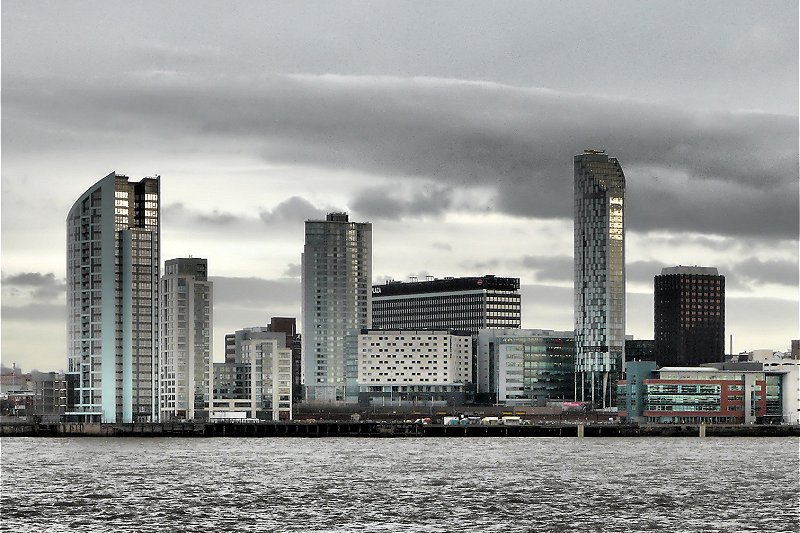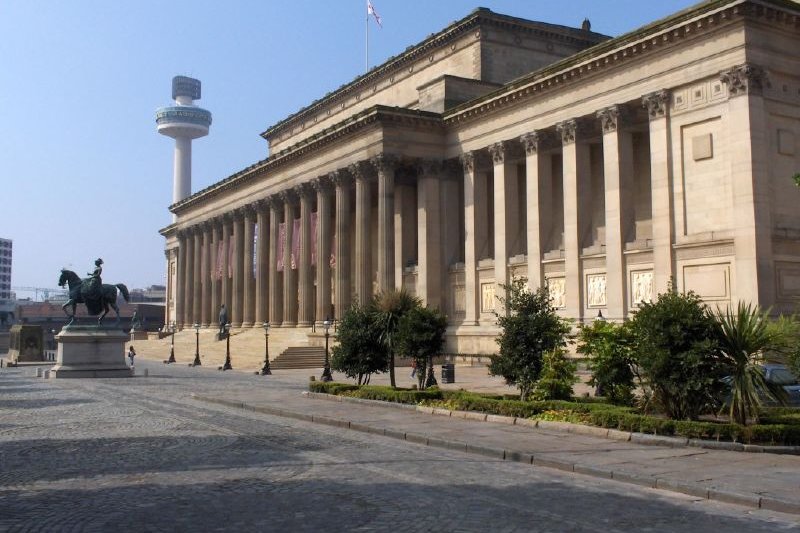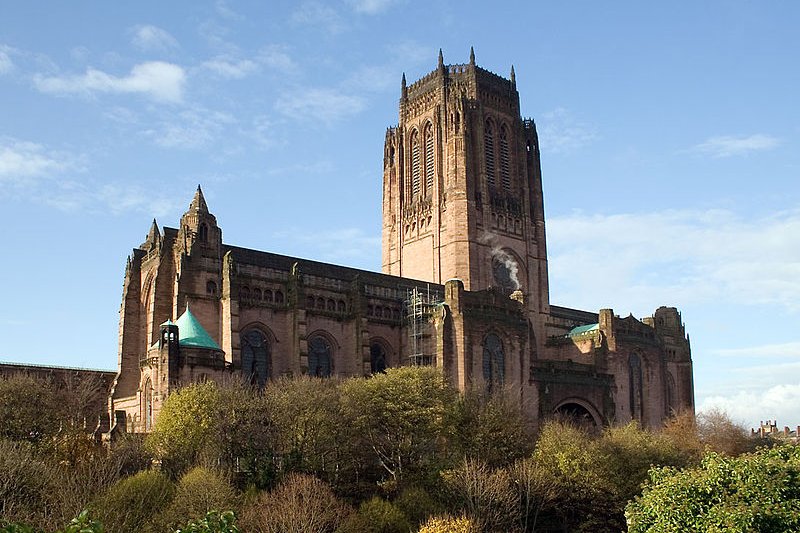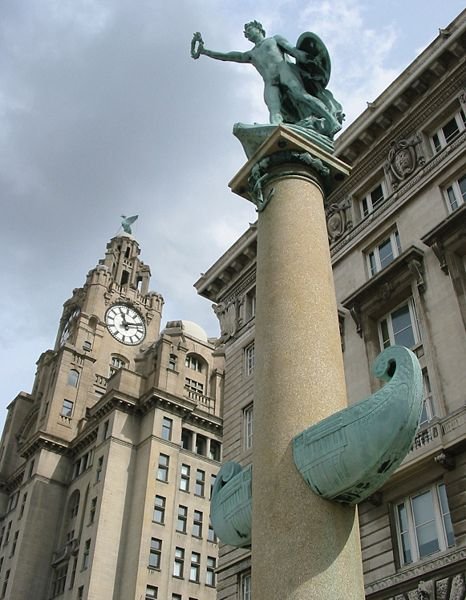 Liverpool, England: Source: https://commons.wikimedia.org/wiki/File:Liverpool_Skyline_with_HMS_Ark_Royal.jpg
Liverpool, England: Source: https://commons.wikimedia.org/wiki/File:Liverpool_Skyline_with_HMS_Ark_Royal.jpgAuthor: Living OS

Liverpool is a city in the borough of Merseyside, on the west coast of England. It was founded some time in AD 1207, and was granted city status in 1880. Presently Liverpool has a population of around 430,000 while the Liverpool Urban Area has a population of 820,000. It is the 4th largest city in UK.
Liverpool benefited from its position as a major British port, especially in the 18th century, when there was an increase in trade with the West Indies, Ireland and mainland Europe. The Atlantic Slave Trade also helped to fuel the expansion of Liverpool. As a measure of Liverpool's importance, 40% of the world's trade passed through its ports in the early 19th century.
 St George's Hall, Liverpool: Source: https://commons.wikimedia.org/wiki/File:St_George%27s_Hall,_Liverpool_%282007%29.jpg
St George's Hall, Liverpool: Source: https://commons.wikimedia.org/wiki/File:St_George%27s_Hall,_Liverpool_%282007%29.jpgAuthor: fabiopauleri

Liverpool is probably best known in the international arena as the home base of the pop group The Beatles, an asset to the city that helps its tourism industry. It celebrated its 800th anniversary in 2007, and in 2008 it held the title of the European Capital of Culture with Stavanger, Norway.
Since 2004, parts of the inner city of Liverpool, including Pier Head, Albert Dock and William Brown Street, along with many of its historic landmarks, were inscribed as a World Heritage Site, referred to as the Liverpool Maritime Mercantile City.
 Liverpool Anglican Cathedral: Source: https://commons.wikimedia.org/wiki/File:Liverpool_Anglican_Cathedral_North_elevation.jpg
Liverpool Anglican Cathedral: Source: https://commons.wikimedia.org/wiki/File:Liverpool_Anglican_Cathedral_North_elevation.jpgAuthor: Solipsist

The Liverpool World Heritage Site
"Liverpool - Maritime Merchantile City" is the designation for the historic centre and docklands of Liverpool which was recognised as a World Heritage Site during the 28th session of the World Heritage Committee which was held in Suzhou, China, on 28 June - 7 July, 2004.World Heritage Site Inscription Details
Location: N 53 24 24.0 W 2 59 40.0Inscription Year: 2004
Type: Cultural
Inscription Criteria: II, III, IV
Going to Liverpool
By Plane: The Liverpool John Lennon Airport (LPL) is the airport serving the city. It gets flights from a number of low-cost carriers including Easyjet and Ryanair. The airport is about 12 km from downtown Liverpool. Immediately outside the Arrival Hall is the bus stop and taxi stand.The Airport Express Bus No. 500 goes to the city centre. The fare is €2.60 per adult for the 45-minute journey. In addition, a few buses by Arriva (80A, 82A and 86A) also goes to the city centre, taking approximately 40 to 45 minutes.
An alternative to flying directly to Liverpool is to fly to Manchester Airport (MAN). From there, you can reach Liverpool within 45-60 minutes. The airport is connected by train run by Northern Rail to the Liverpool Lime Street Station.
By Train: Liverpool's Lime Street Railway Station, in the heart of the city, gets trains from most cities in the United Kingdom. It takes 2 hours by train to reach Liverpool from London - the tickets start at £60 though you can get it for as low as £12.50 if you book weeks in advance. By Bus: National Express and Megabus operate buses to Liverpool from London. The journey takes about 4-5 hours. Usual fare is around £10 though on the low-cost Megabus, you can get a ticket for as little as £1.00 if you book way in advance.
 Cunard House Memorial, with Royal Liver House in the background, Liverpool: Source: https://commons.wikimedia.org/wiki/File:Royal_Liver_Building_Cunard_House_memorial_Liverpool.jpg
Cunard House Memorial, with Royal Liver House in the background, Liverpool: Source: https://commons.wikimedia.org/wiki/File:Royal_Liver_Building_Cunard_House_memorial_Liverpool.jpgAuthor: Man vyi

Exploring Liverpool
It is convenient to explore Liverpool on foot. For longer distances, you can take the bus or the black cabs.Places of Interest in Liverpool
- Royal Liver Building: Grade 1 heritage building in Liverpool.
- Walker Art Gallery: Gallery in Liverpool with one of the largest art collections in England outside of London.
- St George's Hall: Neo-Classical building listed as a Grade 1 heritage building housing concert halls and law courts.
- Albert Dock: 19th century dock that were restored and now house museums, galleries, shops and restaurants.
- Merseyside Maritime Museum: Museum chronicling the history of the Port of Liverpool.
- HM Customs and Excise National Museum: Museum on the history of customs, excise as well as smuggling activities.
- International Slavery Museum: Museum on the history of slavery and the slave trade as related to Liverpool.
- Museum of Liverpool Life: Museum on the history, culture and poeple of Liverpool.
- Beatles Story: Museum exhibiting the history of The Beatles group, from their first record to their last live appearance.
- Tate Liverpool: One of the best collection of contemporary art outside London.
- World Museum Liverpool: Museum with exhibits spanning different periods including Egyptian, Greek, Roman, and more.
- Anglican Cathedral: The largest Anglican cathedral and fifth largest cathedral in the world.
- Metropolitan Cathedral of Christ the King: Modern Roman Catholic cathedral of Liverpool.
Sights around Liverpool
- Speke Hall: Timbered building from 1490.
- Birkenhead: Town across the River Mersey from Liverpool.
- Port Sunlight Village: Victorian village built by soap manufacturer William Heskerth Lever for his factory workers.
- Lady Lever Art Gallery: Gallery housing William Heskerth Lever's collection of works of art.
Liverpool is  on the Map of cities in England
on the Map of cities in England
 Latest updates on Penang Travel Tips
Latest updates on Penang Travel Tips
Map of Ceremonial Counties of England

Copyright © 2003-2025 Timothy Tye. All Rights Reserved.

 Go Back
Go Back